- 1【期中考试-整数反转】_给出一个32位的有符号整数n,请将该数进行反转(正负符号不变,其余数字反转)。 反转
- 2【实验】交换机及VLAN的三层配置_一个vlan10的数据帧从sw1进sw3出,请分别简述两交换机连接端口为access与trunk状况
- 3c#与java的区别_c# java对比
- 4字节跳动技术支持面试小记
- 5基于Python的HTTP隧道安全性分析:魔法背后的锁与钥匙
- 6NOIP/CSP算法竞赛对拍四步曲(windows + NOILinux2.0环境)详细举例_csp 对拍
- 7码云Pages搭建个人静态网站之旅_码云托管静态网页
- 8Git切换远程仓库地址三种方法_git 切换 origin
- 9daily-question-02(前端每日一题02)
- 10情感分类之数据处理_情感分类输出 de csv
【微博爬虫教程&实例】基于requests、mysql爬取大数据量博主关键字下博文及评论
赞
踩
【关键词:手把手教程、反爬、数据库、python爬虫、微博关键词爬虫、较大数据量、数据简单过滤】
本教程适合微博相关爬虫需求者阅读,完整实例源码将放置在文末github链接中。
该实例针对微博的反爬措施进行优化,可实现较大数据量的数据爬取需求(十万量级)。
项目准备
Python & Pycharm
主要使用到的库有:
requests:requests库是Python中用来模拟浏览器发送网络请求与得到响应数据包的库,可以说是实现爬虫原理的核心
json:用于解析(如格式化为方便python处理的字典格式)得到的响应数据包,以便于后续对得到的数据进行操作处理
pymysql:是python下用于对mysql数据库进行相关操作的一个库,本项目中用于将爬取数据加入到本地构建好的数据库中,以及其他的相关操作(增删改查)
Mysql数据库 & Datagrip
为了适用本项目较大规模数据的存放处理以及后续的使用,因此使用了数据库。
如果数据量不大或没有较高的数据分析需要,你也可以考虑将数据以.csv或.xlsx的格式保存(该方式直接在python源码中即可完成,可以看看其他教程)
本项目使用本地sql数据库存放爬取数据,为方便数据库的相关使用,选用Datagrip作为IDE对数据库进行一些操作。
Datagrip界面如下:
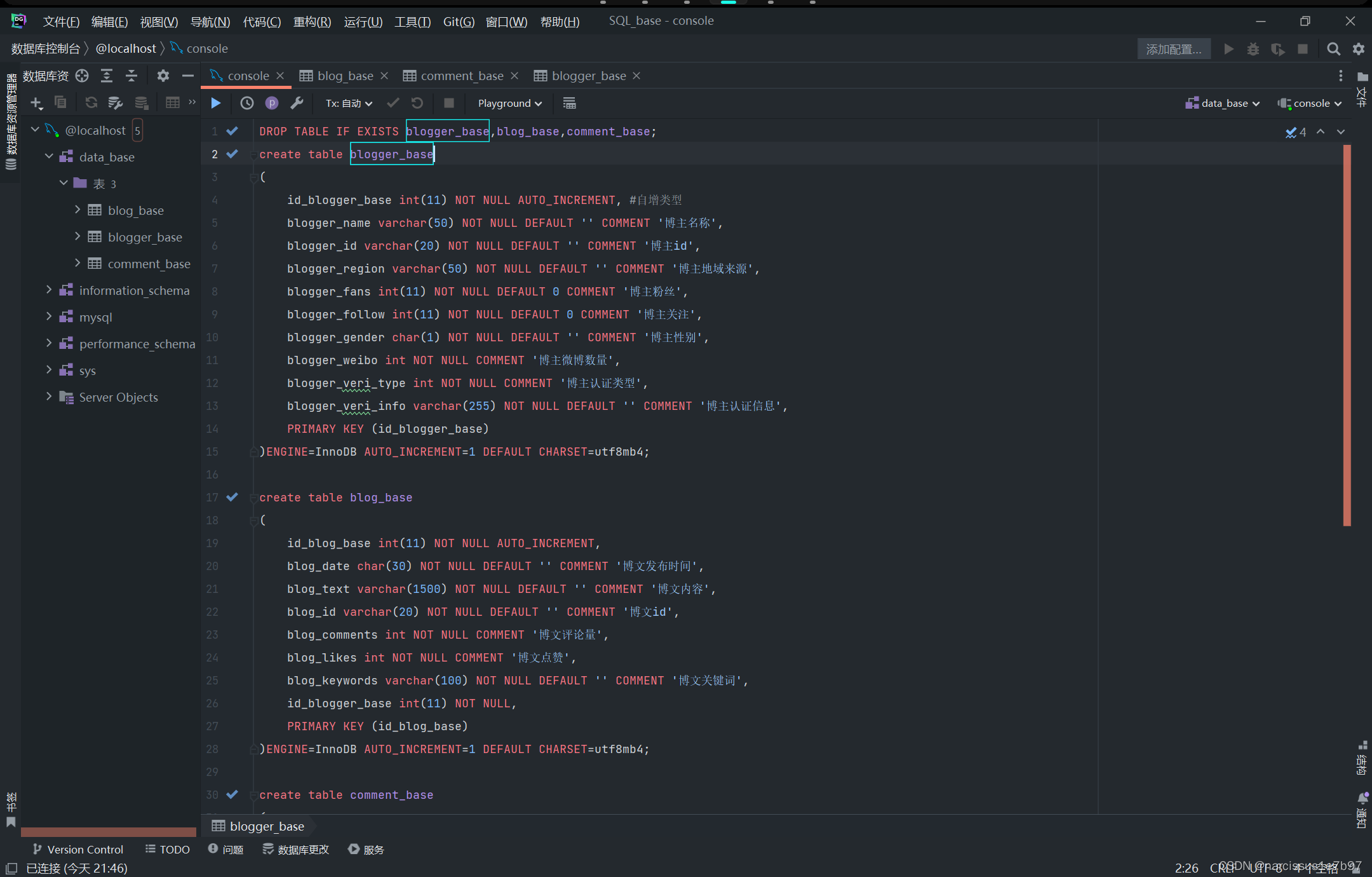
需求分析
本实例希望实现对账号特定时间段内按关键字筛选出的所有博文的爬取,并获得博文评论与评论者个人信息。
数据库结构设计
爬取的数据分博主数据、博文数据、博文评论数据(包含评论者的信息)三种类型。因此我们需要在数据库中建立blogger_table、blog_table、comment_table三个数据表分别存储。
各数据表间通过索引相关联(如comment_table中一条评论数据可由索引对应到blog_table中其所属的博文数据行),以此实现数据间的联系。
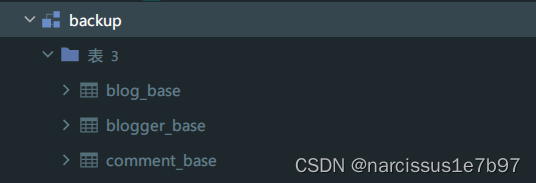
对每一个数据表,其内容是这样的:
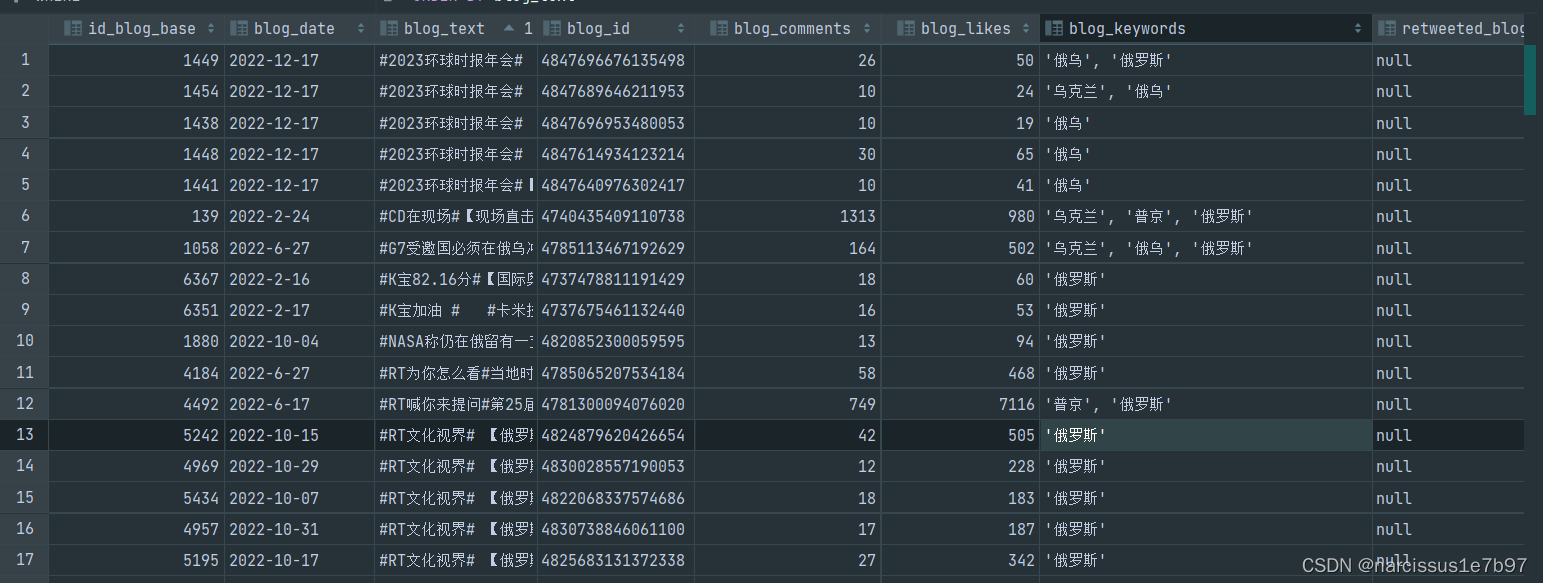
生成该表结构的mysql语句如下:
- create table blog_base
- (
- id_blog_base int(11) NOT NULL AUTO_INCREMENT,
- blog_date char(30) NOT NULL DEFAULT 'null' COMMENT '博文发布时间',
- blog_text varchar(6000) NOT NULL DEFAULT 'null' COMMENT '博文内容',
- blog_id varchar(20) NOT NULL DEFAULT 'null' COMMENT '博文id',
- blog_comments int NOT NULL DEFAULT -100 COMMENT '博文评论量',
- blog_likes int NOT NULL DEFAULT -100 COMMENT '博文点赞',
- blog_keywords varchar(100) NOT NULL DEFAULT 'null' COMMENT '博文关键词',
- retweeted_blogger_name varchar(50) NOT NULL DEFAULT 'null' COMMENT '转推原博主名称',
- retweeted_verified_type int NOT NULL DEFAULT -100 COMMENT '转推原博主认证',
- retweeted_text varchar(3000) NOT NULL DEFAULT 'null' COMMENT '转推原文',
- id_blogger varchar(20) NOT NULL DEFAULT 'null' COMMENT '所属博主id',
- PRIMARY KEY (id_blog_base)
- )ENGINE=InnoDB AUTO_INCREMENT=1 DEFAULT CHARSET=utf8mb4;
数据定位
阅读本内容请先搜索requests库的基本使用,了解get请求与响应的基本概念
定位博主个人信息
1、浏览器打开微博网站(pc版,请务必登录),点开任一博主的个人界面,f12打开开发者工具。
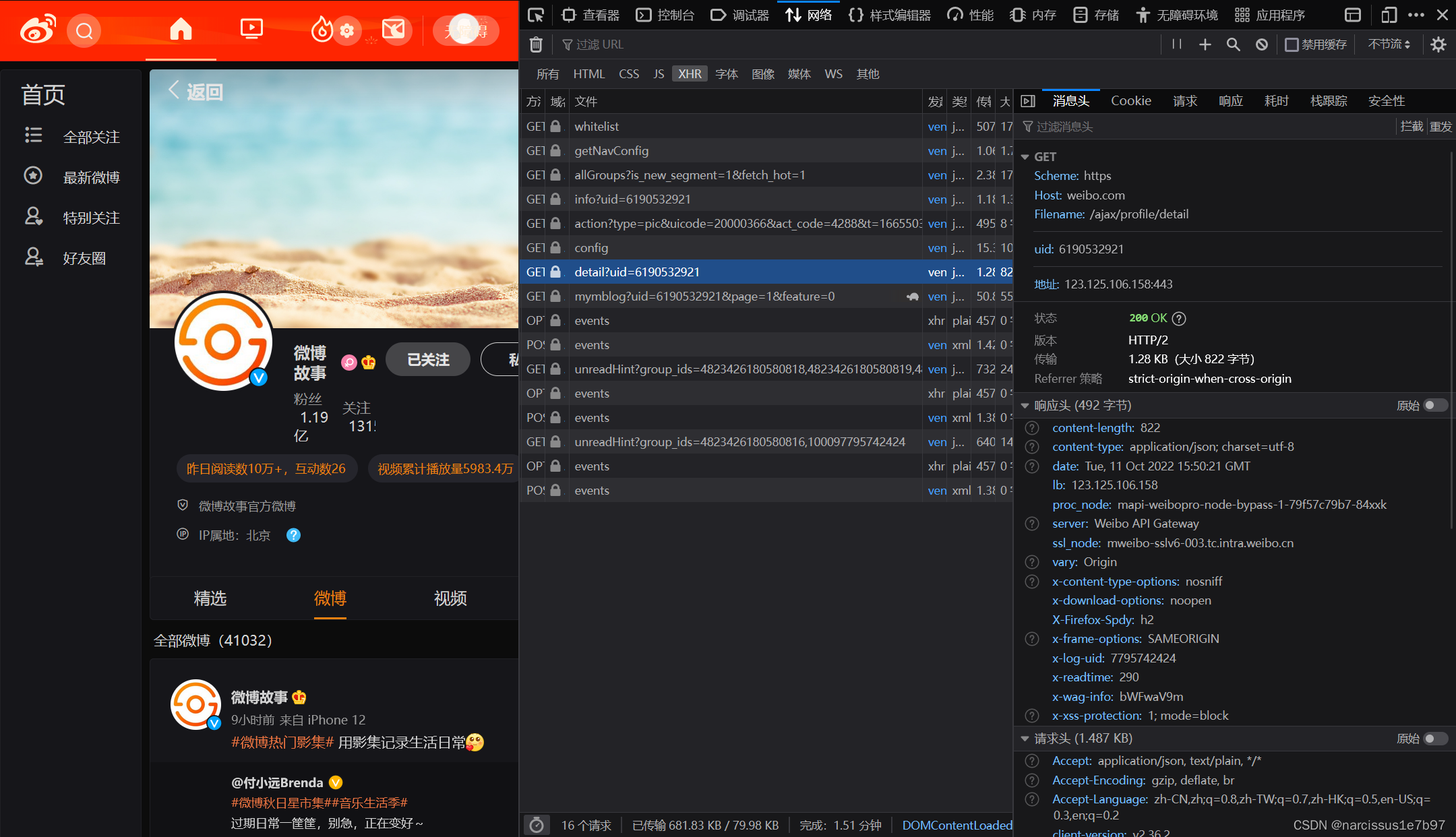
2、选中XHR

3、选中该文件

在右侧栏中找到响应,就可以得到博主的个人信息了(如screen_name、location、gender)。
稍后我们在编写过程中使用requests包模拟浏览器得到该JSON响应文件的过程,然后获得如下图所示的JSON数据,再使用json包将该数据格式化为字典,方便获得想要的数据项。
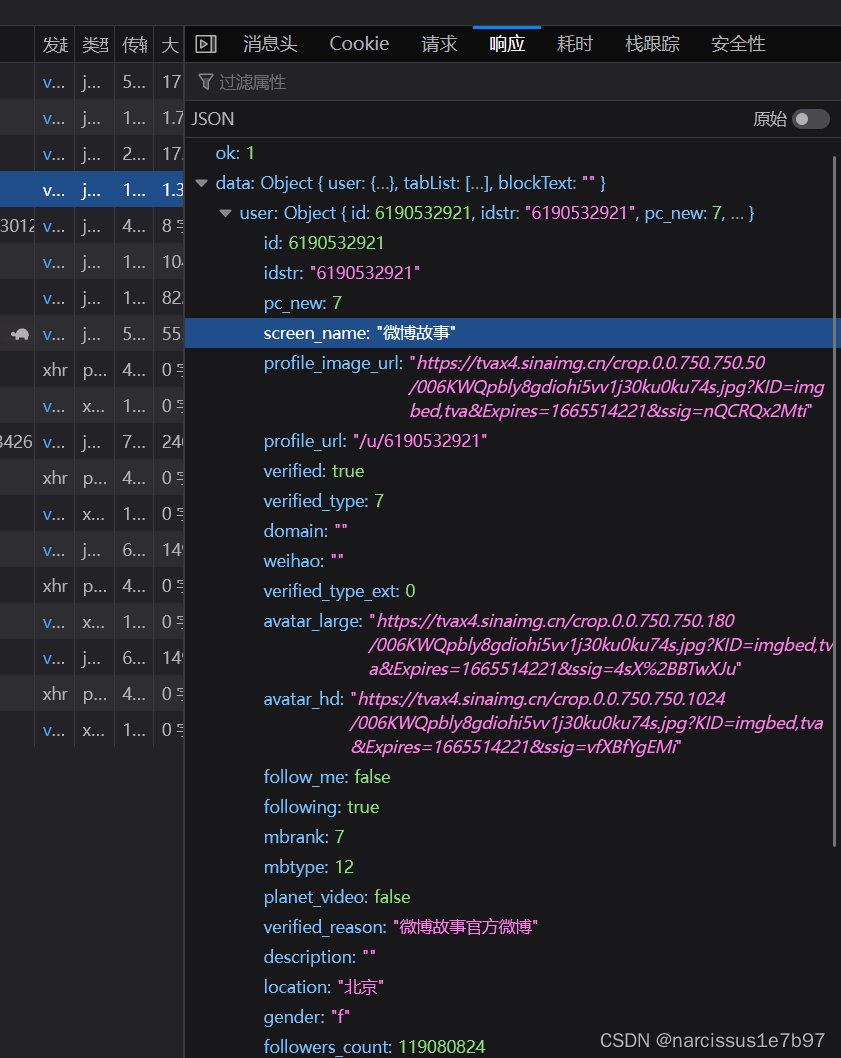
定位博主的博文信息
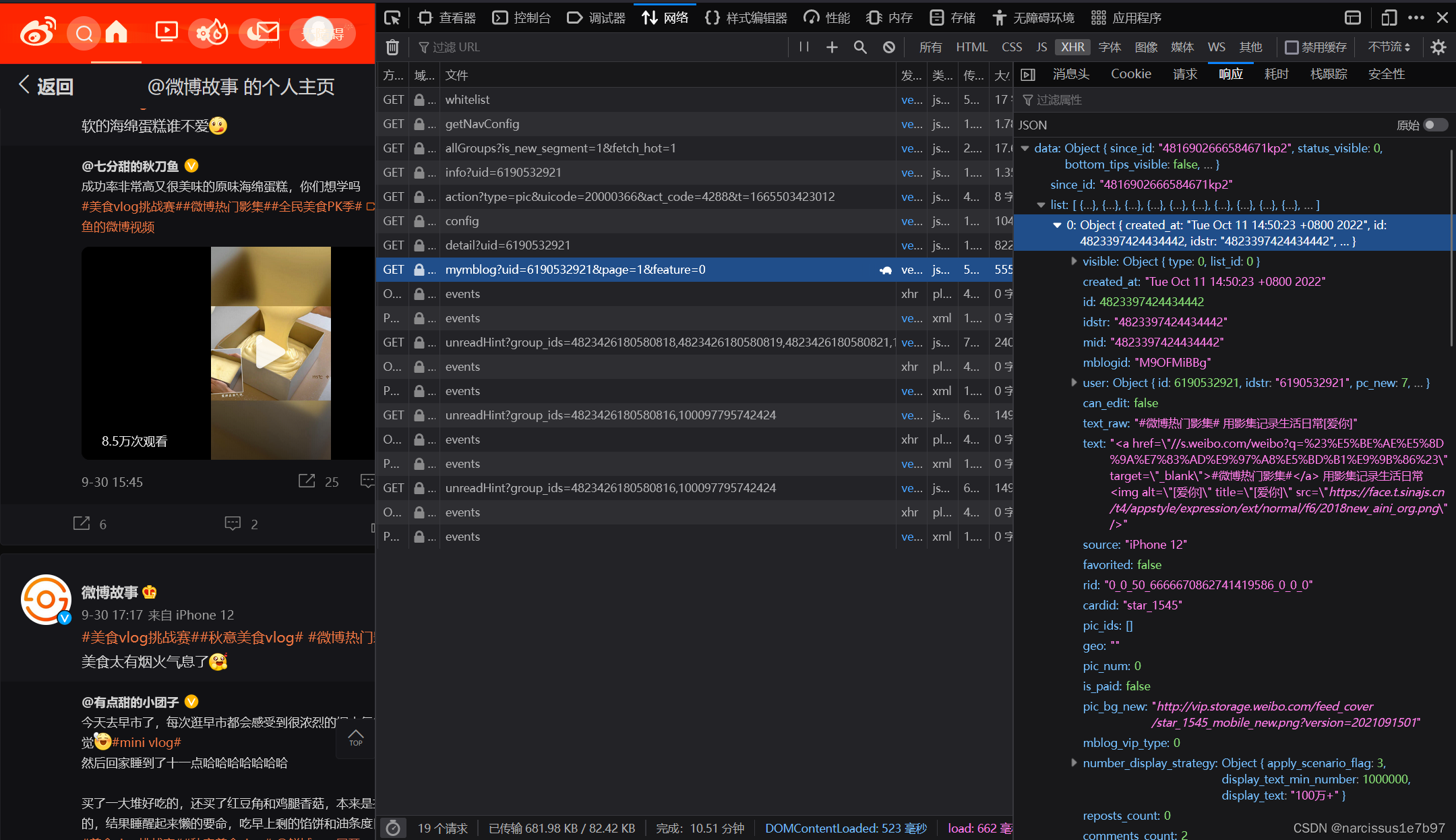
微博博文的响应数据包是按照一页多条blog来发送的,该响应数据包对应的文件名为:

uid这里指博主的用户id,page取不同数是不同页的博文数据包。
下方的若干Object 每一项均为一条博文
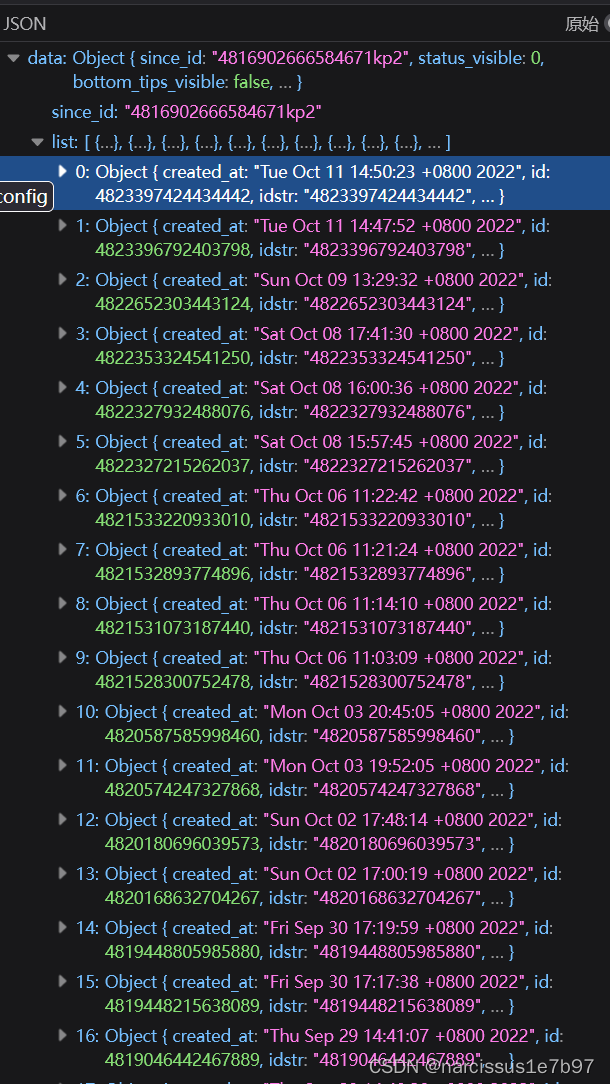
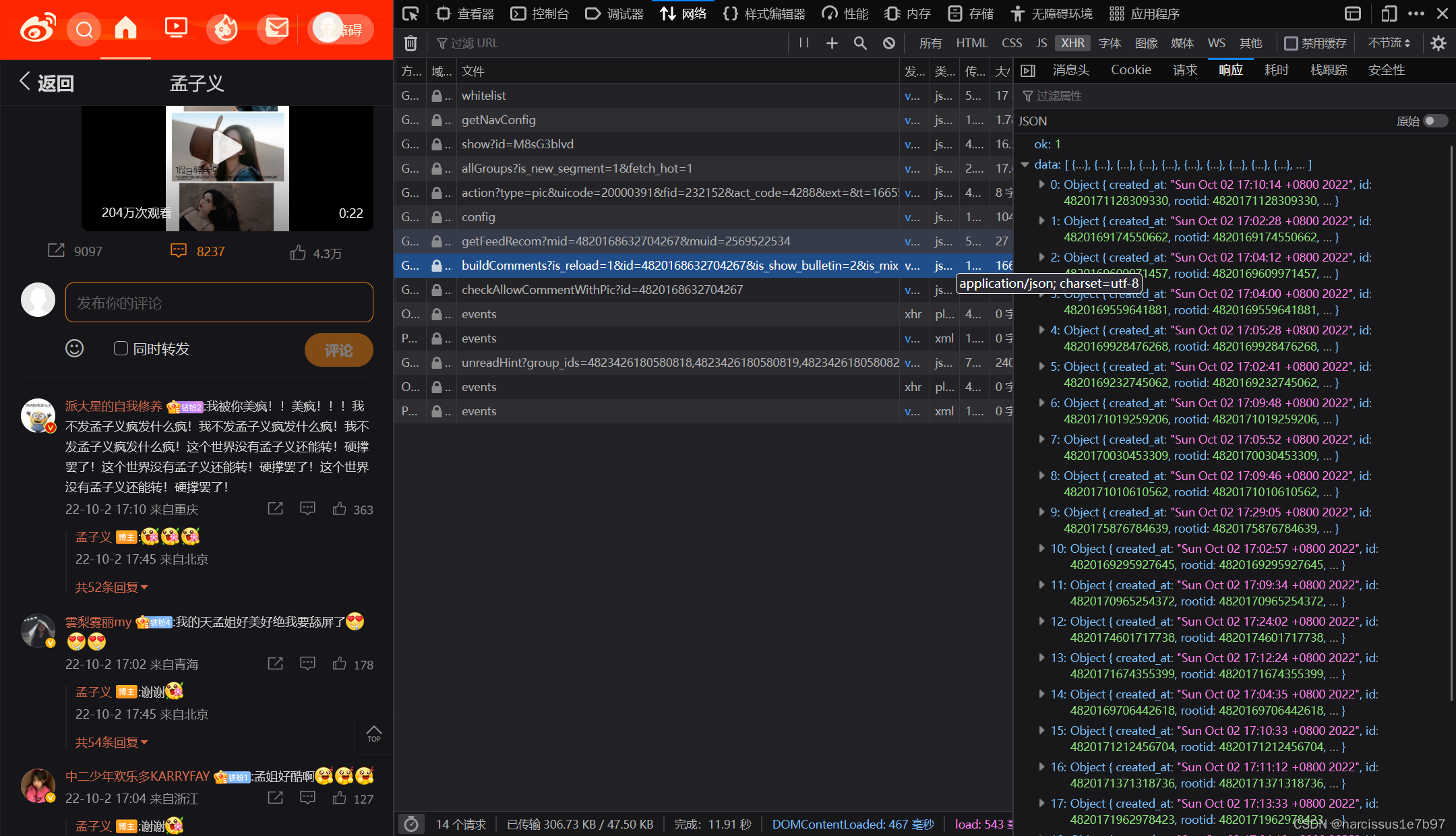
点开一条博文的评论然后进入该博文的详情页,可以得到文件名为:

鼠标滚轮往下翻评论的过程中会刷新出现若干新评论的响应数据包。但值得注意的是,与上一个博文定位不同,此时各数据包的区分并不是用page的增加来实现的

该博文的评论区,除了最前面的若干评论(对应文件列表里未刷新时的唯一一个评论数据包)以外,其余评论数据包的GET请求参数都多了一项参数"max_id" (注意下列两项的GET参数区分,其中一个含有max_id参数)。
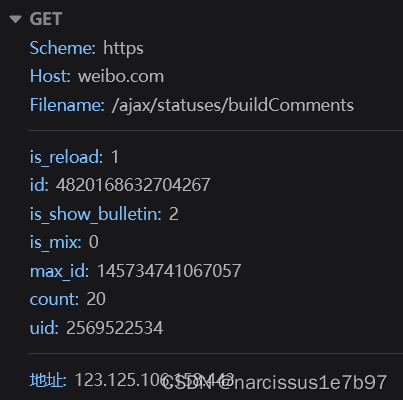
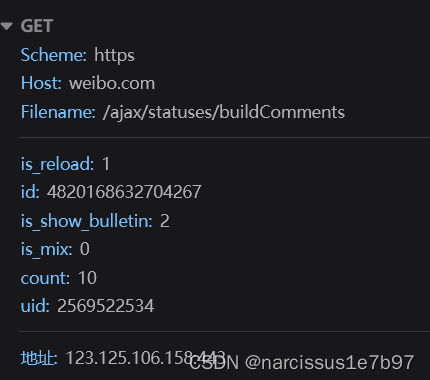
博文的定位中,我们修改page的值然后模拟发送即可获得所有的博文内容,而此处我们无法采用同样的操作——很显然,max_id的数值不是按照page那样自增的规律。
该如何获得该博文的所有的评论呢?我们需要解决如何获得max_id值的问题,否则我们无法正确模拟发送获得后续评论的请求。
解决方法:
1、你会发现前一个评论数据包的响应JSON包含了一个max_id(如图),这个max_id其实是下一个评论数据包GET请求中所需的max_id值
2、因此,只需要获取首个评论数据包的响应JSON中的max_id值,我们就可以获得第二个评论数据包,第二个评论数据包的响应JSON中又包含了一个max_id值,对应下一个评论数据包的GET请求参数,以此类推。最后一个评论数据包的响应JSON不含max_id,可以作为python脚本中该部分过程结束的判断条件。
3、这样我们就可以获得全部的评论信息了
评论用户个人信息定位
该部分的采集伴随评论的采集(评论数据包会同时包含评论者的大部分个人信息)。
代码实现
以下是基本功能的实现过程,下一步会对各函数进行修改以完善。
从用户信息爬起
关于requests库的基本使用在此不做叙述,请查阅其他文章。
1、需要传入的headers项中,我设置了如下四项以确保获得响应JSON。
项目中的cookie我定义为了全局变量,以方便cookie的替换,Connection项设置为close避免过多请求带来的可能异常(或许这一项并不需要?)
2、requests.get()后记得进行utf8编码
3、用json.loads()解析res,得到字典格式的json_data
4、参照之前开发者工具中显示的层级关系,在json_data中获得需要的数据
5、认证信息存在为空但用户是认证用户的情况需要特判(verified_type是200、220这些)
- import requests, json
-
- def user_info(user_id):
- params = {
- 'custom': user_id,
- }
- headers = {
- 'Referer': 'https://weibo.com/' + str(user_id),
- 'Host': 'weibo.com',
- 'Cookie': cookie,
- 'Connection': 'close'
- }
-
- res = requests.get('https://weibo.com/ajax/profile/info', headers=headers, params=params).content.decode("utf-8")
- json_data = json.loads(res)
-
- print('博主id:', json_data['data']['user']['id']) # 博主id
- print('ip归属地:', json_data['data']['user']['location']) # ip归属地
- print('博主名:', json_data['data']['user']['screen_name']) # 博主名
- print('粉丝数:', json_data['data']['user']['followers_count']) # 粉丝数
- print('关注数:', json_data['data']['user']['friends_count']) # 关注数
- print('性别:', json_data['data']['user']['gender']) # 性别(f & m)
- print('总微博数量:', json_data['data']['user']['statuses_count']) # 总微博数量
- print('认证类型:', json_data['data']['user']['verified_type']) # 认证类型
- if json_data['data']['user']['verified_type'] != -1:
- print('认证信息:', json_data['data']['user']['verified_reason']) # 认证信息(注意缺省)
- else:
- print("Not verified")

verified_type的字段:
-1普通用户;
0名人,
1政府,
2企业,
3媒体,
4校园,
5网站,
6应用,
7团体(机构),
8待审企业,
200初级达人,
220中高级达人,
400已故V用户。
-1为普通用户,200和220为达人用户,0为黄V用户,其它即为蓝V用户
爬取博主博文
从前述内容可以看出,博文是按照一个个json文件由服务器发给浏览器的。我们按照月份先打包所有该博主某月的所有博文(对应的一系列JSON文件),然后再根据关键字对其中需要的博文进行筛选以及进行评论的爬取。
注意,为了加快效率,我们在程序中设置了多线程。因而有task_queue.put(json_data)入队列的过程。(该处理原理是多线程任务的生产者-消费者模型)
并且在爬取过程中有一定概率会请求服务器失败,我设置了重新请求的处理(retried_times)
- # 请求单页博文页的函数
- def post_req(user_id, page, curmonth, retried_times):
- headers = {
- 'Host': 'weibo.com',
- 'Referer': 'https://weibo.com/' + user_id + '?refer_flag=1001030103_',
- 'User-Agent': 'Mozilla/5.0 (Windows NT 10.0; Win64; x64; rv:105.0) Gecko/20100101 Firefox/105.0',
- 'Cookie': cookie,
- }
- params = {
- 'uid': user_id,
- 'page': page,
- 'feature': 0,
- 'displayYear': 2023,
- 'curMonth': curmonth,
- 'stat_date': '2023' + str(curmonth).rjust(2, '0'),
- }
- if retried_times < 5:
- try:
- res = requests.get('https://weibo.com/ajax/statuses/mymblog', headers=headers,
- params=params).content.decode('UTF-8')
- except:
- traceback.print_exc()
- random_sleep()
- retried_times += 1
- post_req(user_id, page, curmonth, retried_times)
- else:
- json_data = json.loads(res) # 加载json文件
- if json_data['data']['list']:
- return json_data
- else:
- return None
- else:
- return -1
-
-
- # 打包所有当月博文json
- def post_page_list_producer(task_queue, user_id, curmonth):
- post_page = 1
- while True:
- # random_sleep()
- json_data = post_req(user_id, post_page, curmonth, retried_times=0)
- if json_data is None:
- print('全部博文包请求成功,完成打包')
- break
- elif json_data == -1:
- return -1
- else:
- task_queue.put(json_data)
- print('博文包请求成功', 'month:', curmonth, 'page:', post_page)
- post_page += 1
- random_sleep()

打包完成后,我们使用遍历对所有博文据关键字筛选,然后对博文信息进行写入数据库操作。
- def post_json_data_insert(user_id, object, in_db, in_cursor, inserted_list):
- # 处理关键字并匹配
- pattern = re.compile('|'.join(key_words))
- text = object['text_raw']
- result_findall = pattern.findall(text)
-
- if result_findall and object['comments_count'] >= 10:
- if object['id'] not in inserted_list:
- date_formatted = date_format(object)
- if '<span class="expand">展开</span>' in object['text']:
- mblogid = object['mblogid']
- req = long_text_req(user_id, mblogid)
- print(object['text_raw'])
- object['text_raw'] = req['data']['longTextContent']
- print(object['text_raw'])
- if 'retweeted_status' in object:
- print("#################################################")
- print(object['retweeted_status']['user']['verified_type'])
- print(object['retweeted_status']['text_raw'])
- print("#################################################")
- in_cursor.execute(
- "INSERT INTO blog_base("
- "blog_date,"
- "blog_text,"
- "blog_id,"
- "blog_comments,"
- "blog_likes,"
- "blog_keywords,"
- "id_blogger,"
- "retweeted_blogger_name,"
- "retweeted_verified_type,"
- "retweeted_text"
- ") VALUES(%s,%s,%s,%s,%s,%s,%s,%s,%s,%s); ",
- (date_formatted,
- object['text_raw'],
- object['id'],
- object['comments_count'],
- object['attitudes_count'],
- str(set(result_findall)).strip('{}'),
- user_id,
- object['retweeted_status']['user']['screen_name'],
- object['retweeted_status']['user']['verified_type'],
- object['retweeted_status']['text_raw']
- )
- )
- else:
- in_cursor.execute(
- "INSERT INTO blog_base("
- "blog_date,"
- "blog_text,"
- "blog_id,"
- "blog_comments,"
- "blog_likes,"
- "blog_keywords,"
- "id_blogger"
- ") VALUES(%s,%s,%s,%s,%s,%s,%s); ",
- (date_formatted,
- object['text_raw'],
- object['id'],
- object['comments_count'],
- object['attitudes_count'],
- str(set(result_findall)).strip('{}'),
- user_id
- )
- )
- in_db.commit()
- print('相关博文', object['text_raw'], '\n')
- counts = 0
- # 调用评论抓取函数
- if post_comment_data(user_id, object['id'], in_db, in_cursor, counts) is None:
- print('id%s 评论获得失败,删除该条博文数据、程序终止' % object['id'])
- in_cursor.execute("delete from comment_base where id_blog=%s" % object['id'])
- in_cursor.execute("delete from blog_base where blog_id=%s" % object['id'])
- in_cursor.commit()
- return -1
- inserted_list.append(object['id']) # 记录该博文id防止重复
- return 1
- else:
- print('id%s 已存博文,跳过该条' % object['id'])
- return 1
- else:
- print('无关博文(comments_count:%s)' % object['comments_count'])
- return 1
-
-
- # 消化队列中的博文json
- def post_data_get_consumer(task_queue, user_id, inserted_list): # 多线程处理page的json_data
- global thread_status
- in_db = pymysql.connect(host='localhost', port=3306, user='root', passwd='root', db='dataday0224',
- charset='utf8mb4')
- in_cursor = in_db.cursor()
- while task_queue.empty() is not True:
- json_data = task_queue.get()
- for object in json_data['data']['list']:
- date_formatted = date_format(object)
- if is_that_day(date_formatted):
- if post_json_data_insert(user_id, object, in_db, in_cursor, inserted_list) == -1:
- print('由于本条博文数据插入失败,该线程结束')
- thread_status = -1
- return -1
- else:
- print(date_formatted+'is not wanted date')
- task_queue.task_done()

在post_json_data_insert()的尾部我们调用了post_comment_data函数进行博文下评论的爬取。需要注意的是,由于评论信息存在一个需要特别关注的max_id参数需要处理,post_comment_data采集完第一次评论数据后,后续的评论数据会调用post_comment_data_rest()函数来处理max_id问题:
- def post_comment_data_rest(user_id, post_id, max_id, in_db, in_cursor, counts):
- headers = {
- 'Host': 'weibo.com',
- 'Referer': 'https://weibo.com/' + str(user_id) + '?refer_flag=1001030103_',
- 'User-Agent': 'Mozilla/5.0 (Windows NT 10.0; Win64; x64; rv:105.0) Gecko/20100101 Firefox/105.0',
- 'Cookie': cookie,
- # 'Connection': 'close'
-
- }
- params = {
- 'flow': 1,
- 'id': post_id,
- 'is_show_bulletin': 2,
- 'count': 20,
- 'max_id': max_id,
- }
- try:
- res = requests.get('https://weibo.com/ajax/statuses/buildComments', headers=headers,
- params=params).content.decode('UTF-8')
-
- json_data = json.loads(res) # 加载json文件
- except:
- print('【' + str(post_id) + '】''post_comment_data_rest() request error, trying again...')
- traceback.print_exc()
- try:
- post_comment_data_rest(user_id, post_id, max_id, in_db, in_cursor, counts)
- except:
- print("retried failed")
- return None
- else:
- for object in json_data['data']:
- if counts >= 1000:
- break
-
- date_formatted = date_format(object)
- random_sleep()
- print('【', str(date_formatted), '[' + str(object['floor_number']) + ']】', '正在存储该条评论, postID:',
- post_id)
-
- user_json = object['user']
-
- if user_json['verified_type'] != -1:
- try:
- veri_info = user_json['verified_reason'] # 认证信息(注意缺省)
- except:
- veri_info = ''
- else:
- veri_info = "Not verified"
-
- try:
- in_cursor.execute(
- "INSERT INTO comment_base("
- "comment_date,"
- "comment_text,"
- "commenter_name,"
- "commenter_region,"
- "commenter_id,"
- "commenter_fans,"
- "commenter_follow,"
- "commenter_gender,"
- "commenter_weibo,"
- "commenter_veri_type,"
- "commenter_veri_info,"
- "id_blog"
- ") VALUES(%s,%s,%s,%s,%s,%s,%s,%s,%s,%s,%s,%s);",
- (date_formatted,
- object['text'],
- object['user']['screen_name'],
- user_json['location'],
- object['user']['id'],
- user_json['followers_count'],
- user_json['friends_count'],
- user_json['gender'],
- user_json['statuses_count'],
- user_json['verified_type'],
- veri_info,
- post_id
- )
- )
- in_db.commit()
- counts += 1
- except:
- print('An sql error on post_comment_data_rest')
- print(object['text'])
- traceback.print_exc()
-
- if json_data['max_id'] != 0:
- random_sleep()
- return post_comment_data_rest(user_id, post_id, json_data['max_id'], in_db, in_cursor, counts)
- else:
- return 1

该程序的主功能集成函数为:
- def all_post_data(user_id): # user_id的全体博文内容获取
- global thread_status
- thread_status = 1
-
- months = [2, ]
-
- restartPoint = None
- while True: # 生产者队列获取页面json失败时,重复该月json获取
- for curmonth in months:
- if restartPoint:
- if curmonth != restartPoint:
- continue
- print('正在打包博主%s月的全部博文页...' % curmonth)
- task_queue = Queue()
- if post_page_list_producer(task_queue, user_id, curmonth) == -1: # 队列一次性获得全部的当月博文页
- restartPoint = curmonth
- break
-
- inserted_list = []
- thread_list = []
- for index in range(20):
- consumer_thread = Thread(target=post_data_get_consumer, args=(task_queue, user_id, inserted_list))
- thread_list.append(consumer_thread)
- for t in thread_list:
- t.start()
- for t in thread_list:
- t.join()
- if thread_status == -1:
- print('有线程未完成任务,程序终止:检查用户 %s 的 %s 月博文数据' % (user_id, curmonth))
- exit()
- else:
- print('用户 %s 的 %s 月数据采集完成' % (user_id, curmonth))
-
- restartPoint = None
- if restartPoint is None:
- break

自此,对代码的主要设计部分讲解结束。除此之外,脚本中还有一些边缘的函数(如日期格式化、处理文本内容采集不全的函数)。
完整代码请访问我的github项目:GitHub - otonashi-ayana/SpiderWeibo: Collect blog posts and comments, commentator information and build a database
一些问题的说明
国内的ip免费/付费代理商不接单访问微博的ip代理服务(政策原因),因而通过该方法解决微博反爬冻结ip不可行。本实例可在若干小时内采集到上十万规模的博文以及评论数据
本人代码水平堪忧,本代码中的多线程部分与异常处理非常混乱(),同时该项目前后经过了很长一段时间修改,其屎山程度有目共睹。不过本实例中的一些细节问题在网络上没有查阅到相关资料,博主希望能够帮助到遇到同样问题的各位。
效果展示
博文数据采集数据库的展示(549,186行数据):
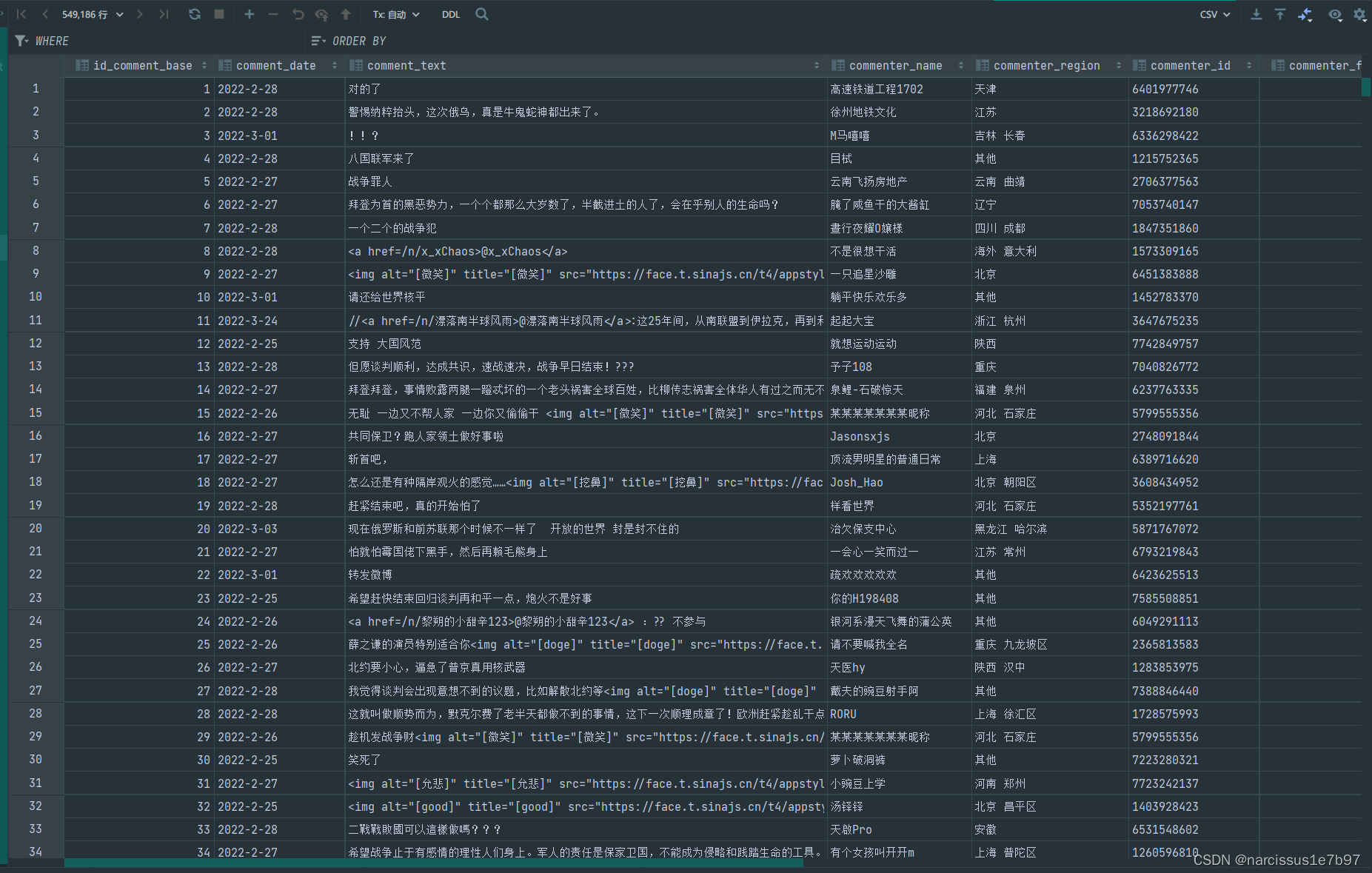
其中每一行评论都会记录其所属的博文id,通过博文id可以找到博文数据表中对应的博文,实现了数据之间的关联:
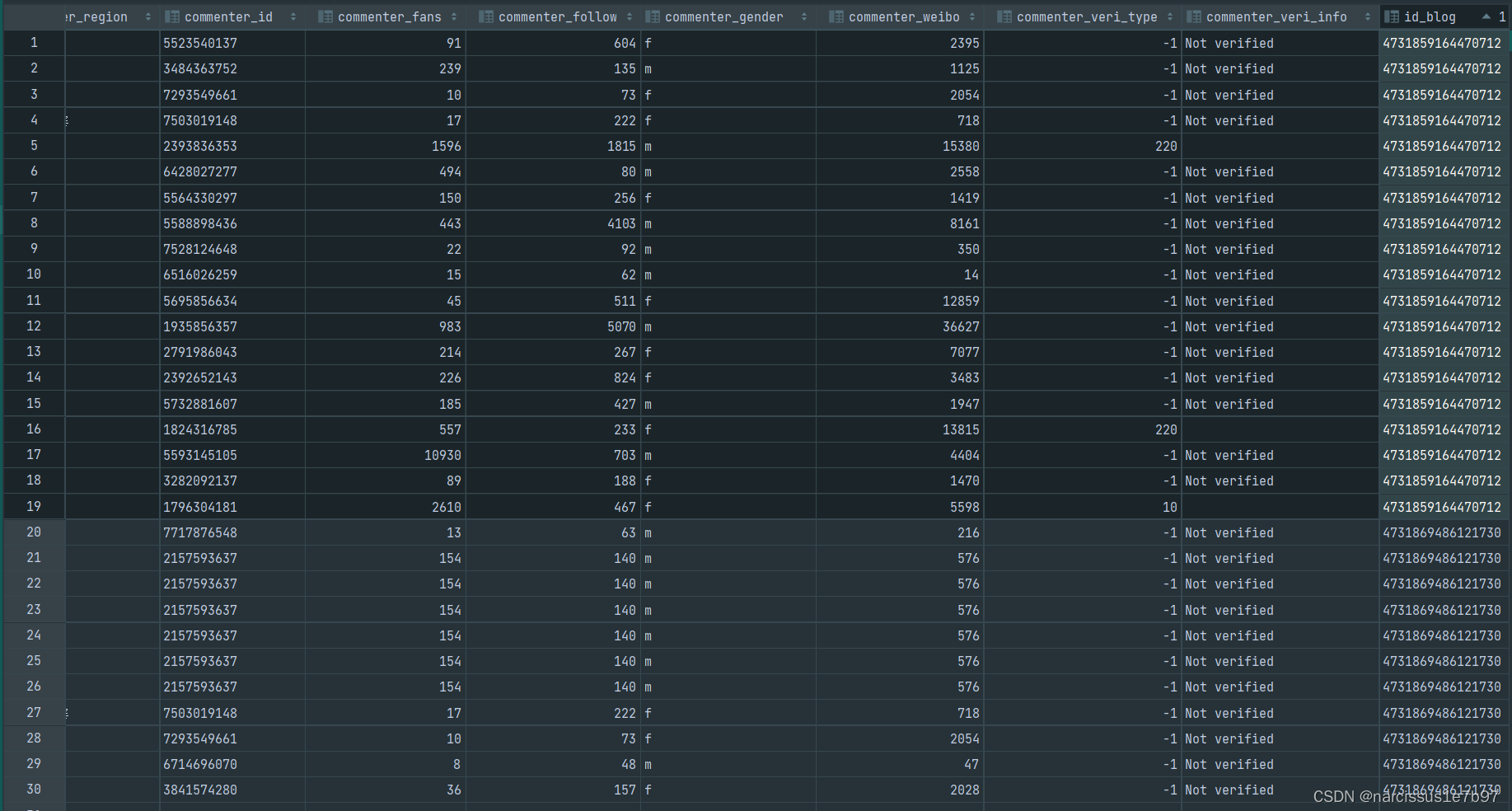
感谢你的阅读。
- 本篇博客将介绍MySQL数据库的社区版安装过程,包括下载、安装、配置和客户端连接等步骤。通过本文,读者将了解如何在其计算机上安装MySQLCommunityServer8.0.26,并配置环境变量以及启动停止MySQL服务。(内容超级干货)... [详细]
赞
踩
- 讲解有关数据库字符集和校验规则;操作数据库,包括查看数据库、修改数据库、删除数据库以及对数据库进行备份和恢复;表的操作,包括创建表结构、查看表结构、修改表结构、删除表【MySQL】数据库和表的操作数据库和表的操作一、数据库的操作1.创建数据... [详细]
赞
踩
- 文章详细介绍了mysqlworkbench的下载和使用。_workbench下载workbench下载目录一、MySQLworkbench的下载和安装1. MySQL workbench介绍2.到MySQL官网下载mys... [详细]
赞
踩
- MySQL中的数据类型:数值类型、小数类型、字符串类型等。_mysqlenummysqlenum文章目录数据类型分类数值类型小数类型字符串类型日期类型和时间类型enum和set数据类型分类数值类型:用于存储数值,包括整型和浮点型,如int、... [详细]
赞
踩
- 图书管理系统,通过我们在借书还书的过程中,对数据库进行一系列操作_mysql图书管理系统mysql图书管理系统1.需求分析1.1项目需求分析简介1.1.1信息需求分析(1)图书信息:包括书籍编号,书籍名称,出版社,作者,库存量,出版日期,价... [详细]
赞
踩
- 在数据库查询中,开窗函数(WindowFunctions)是一种强大的工具,用于在结果集的子集上执行计算。LAG和LEAD是两个常用的开窗函数,它们允许你在当前行的前面或后面的行中访问数据。在数据库中,LAG和LEADLAG函数的全称是"L... [详细]
赞
踩
- 承接上文,继续讲一下MySQL提示:以下是本篇文章正文内容,下面案例可供参考好了,这个是mysql的一些知识,希望大家支持呀~~{MySQL}数据库约束&表的关系&新增&&删除&修改&查询提示:文章写完后,目录可以自动生成,如何生成可参考右... [详细]
赞
踩
- mysql+elasticsearch数据双写设计与实现_javaesmysql双写事务javaesmysql双写事务目录一、前言二、为什么使用mysql+es双写2.1单用mysql的问题2.2为什么不直接使用es... [详细]
赞
踩
- 一万八千多字总结MySQL最全JSON函数详解和实战(你要的全部都有),处理各种JSON数据。建议收藏以备后续用到查阅参考。_mysqljson_arraymysqljson_arrayMySQL提供了许多JSON函数,用于对JSON数据进... [详细]
赞
踩
- 在配置文件/etc/my.cnf添加错误日志参数,一切问题都解决启动报错时查看日志信息:发现日志输出肯定是配置文件里加入了这个错误参数,去掉即可新加报错:这是在mysql新版本:5.6.35,5.6.36的一个bug参考:https://b... [详细]
赞
踩
- 该博客教程旨在帮助初学者了解如何在Java前端和MySQL数据库之间建立连接。通过简单易懂的指导,教程覆盖了从前端到后端的完整流程。首先,它介绍了Java编程语言的基础知识,为初学者提供了必要的背景。接着,教程引导读者学习如何使用Java中... [详细]
赞
踩
- 介绍数据库中的数据类型,包括数值类型、字符串类型、日期类型和时间类型、enum和set.【MySQL】数据库的数据类型数据类型一、数据类型分类二、数值类型1.tinyint2.bit3.小数类型(1)float(2)decimal三、字符串... [详细]
赞
踩
- 在MySQL中,我们可以使用变量或内置函数来获取每行数据的行号。使用变量的方法可以适用于MySQL中的大多数版本,而使用内置函数的方法可以在MySQL版本8.0.2及以上使用。参考原文:https://deepinout.com/mysql... [详细]
赞
踩
- 如果最后操作运行时出错,可能是SC表设置了外键约束的问题,它可能报这种错误,原因是想要删除的数据和表与其他的数据或表存在主外键关系,MYSQL规定为了维护表结构的稳定,禁止执行该操作,即外键约束失败解决方法,将带有外键约束的表删掉,,然后重... [详细]
赞
踩
- 根据需求我们得知要恢复误删除的这张表,那么在事件信息中找到创建该表的事件,这个事件的开始标识位就作为我们截取Binlog日志的开始标识位号,结束标识位更好确定了,在事件信息中找到删除表的事件,这个事件的开始标识位也就作为我们截取Binlog... [详细]
赞
踩
- 本博主将用CSDN记录软件开发求学之路上亲身所得与所学的心得与知识,有兴趣的小伙伴可以关注博主!也许一个人独行,可以走的很快,但是一群人结伴而行,才能走的更远!在创建表时,每个列都必须指定数据类型。MySQL提供了各种内置数据类型,如整数、... [详细]
赞
踩
- 本文使用图文详细介绍Windows下通过zip包方式安装MySQL8.1.0最新版本。这种安装方式适合学习和定制,让您轻松搭建学习环境,掌握MySQL数据库的使用和配置,为您的MySQL学习之旅打下坚实基础。_windowsmysql8.1... [详细]
赞
踩
- 填坑_微信小程序使用npm支持mysql微信小程序使用npm支持mysql前言博主自己在22年夏天根据课程要求做了一个小程序连接阿里云服务器的案例,在最近又碰到了相应的需求。原参考文章:微信小程序Node连接本地MYSQL_微信小程序nod... [详细]
赞
踩
- 通过selenium模拟登录,获取cookies,传递给requests,以绕过加密登录及页面跳转。通过第三方识别验证码,借助requests向服务器发送请求,实现“瞬间预约”。_selenium登录后访问其他页面selenium登录后访问... [详细]
赞
踩
- Yearning简单,高效的MYSQL审计平台一款MYSQLSQL语句/查询审计工具,为DBA与开发人员使用.本地部署,注重隐私,简单高效的MYSQL审计平台。下面介绍Linux简单部署Yearning并结合cpolar内网穿透工具实现远程... [详细]
赞
踩







